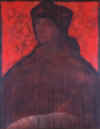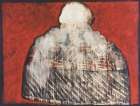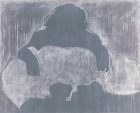
 |
|
|
Federica Palomero |
|||
 (2) Still Life, after Zurbarán zoom |
||||
| Bugallo allows a new expression that has nothing to do with the icon of the original reference. His neo-iconographies do not have the mere transitive function of leading to the pictorial signification but have the value of being meaningful themselves. The work is proposed as the breaking of an order of pictorial and sign conventions. |  (3) Madame Moitessier, after Ingres zoom |
|||
| Milagros Bello | ||||
 (4) Meninas, after Velázquez zoom |
In his works some of the landmarks in art are re-taken: the theme is recreated in new forms and new techniques. Thus we see a Venus of Urbino, silhouetted, beautifully synthetic, placidly lying down in the scarceness of its shapes and colors; Marat’s Death, moving in the purity of its classical rhythm and in its countless connotations: the French Revolution, the humanistic ideals, Marat, David… and Bugallo again. The original image is enlarged, it is covered with new textures, new colors, it comes near the symbol; it speaks to us from several levels: that of the original image and its whole context, that of the new image, recreated, and that of painting in general; because every reelaboration is, in the end, a question and, in this case, the search of painting. Katherine Chacón |
|||
 (5) A Portrait of the Cardinal, after Raphael zoom |
||||
 |
 |
 |
||
| (6) Battle of San Romano, after Ucello zoom |
(7) Untitled (Infanta Margarita, after Velázquez) zoom |
(8) Untitled (Piedad de Avignon) zoom |
||
| The attempt to
understand and express a sense in art is the conceptual scaffold on which Bugallo’s
recent pictorial production stands. It is clearly revealed by the compact relation the
artist has managed to establish between two basic components that define his work: an
evocative character ( seen in the development of a synthesizing intention) and a
conceptual one (conveyed by the repetition of images or elements with a particular
semantic or symbolic power). Adolfo Wilson |
||||
 |
||||
| (9) The Dead Christ, after Mantegna zoom |
(10) The Dead Christ, after Philippe de Champaigne zoom |
|||
home | anthology | image and likeness | catalog | resume | español | e-mail | arte en la red |
||||
| © 1999
Francisco Bugallo All images are protected by international copyright laws. Reproduction without a written authorization is forbidden. |
||||